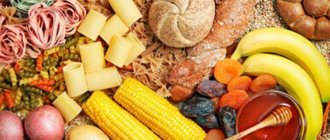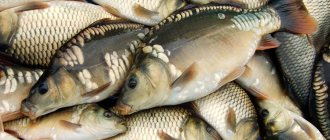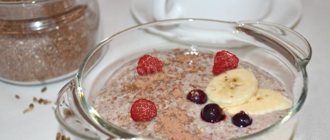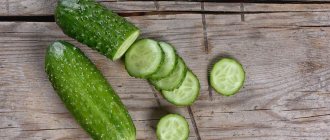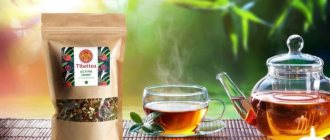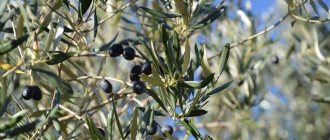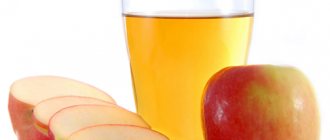Chemical composition and calorie content of lamb fat
The beneficial properties of fat tail depend on its type, as well as the gender of the livestock. An animal product contains many valuable components and nutrients, the percentage of which may vary slightly depending on the type of raw material.
Average fat composition of young sheep:
- Fats (saturated, monounsaturated, polyunsaturated) – 97%;
- Water – 0.3%;
- Vitamins D, E, B4 – 2%;
- Macroelements (phosphorus, sulfur, chlorine, sodium, selenium) – 0.5%;
- Cholesterol.
Nutritional value per 100 g of edible portion, relative to a person’s daily intake:
| Lamb fat | % of the daily value of 100 g | |
| Squirrels | 0 g | 0 |
| Fats | 99.7 g | 166,2% |
| Carbohydrates | 0 g | 0 |
| Calorie content | 898 kcal | 54% |
Important! Due to the peculiarities of the chemical composition, it is not recommended to consume lamb fat as an independent dish. In its pure form, it can cause harm to the body.
Stewed fat tail with vegetables
- Time: 30 minutes.
- Number of servings: 4 persons.
- Calorie content of the dish: 153 kcal per 100 grams.
- Purpose: for lunch, dinner.
- Cuisine: oriental.
- Difficulty: easy.
A stew of vegetables stewed in fat tail is a hearty dish that can become a full meal. According to the recipe, the stew is made from fresh cabbage; you can use a mixture of fresh and pickled cabbage leaves, or just sauerkraut. If you decide to choose the latter option, then it is better to pre-soak the pickled cabbage leaves in water to get rid of excess salt.
Ingredients:
- fresh cabbage – 1 kg;
- fat tail – 250 g;
- green onions – 50 g;
- cumin – 5 g;
- tomatoes – 4 pcs.;
- onion – 1 pc.;
- salt - to taste.
Cooking method:
- Finely chop the fresh cabbage, add salt, and crush it a little with your hands.
- Cut the lamb fat into small pieces and heat it in a frying pan.
- Fry the finely chopped onion in melted fat until golden brown.
- Place the cabbage in the pan.
- Pour boiling water over the tomatoes, remove the skin, cut into medium cubes, and add to the rest of the vegetables.
- Following the tomatoes, add green onions cut into rings and season with spices.
- Add some liquid if necessary.
- Serve the stew warm as a separate dish.
Varieties of lamb fat
The fat is made from various types and parts of the carcass of fat-tailed sheep. In the food industry there are three varieties:
- Higher. It is made from melted selected lamb fat tail (fat deposit in the lamb tail area). The product made from such lamb fat is soft, has a yellowish-white color and melts even at low temperatures, minimally losing its beneficial properties during heat treatment. This variety is rightfully considered the best and most expensive;
- First. This type of lamb fat is obtained from internal organs or raw meat. It has a gray tint and tastes like fried cracklings;
- Second. Made from lard. It has a cloudy color and a characteristic taste.
Honey tail
- Time: 30 minutes.
- Number of servings: 2 persons.
- Calorie content of the dish: 830 kcal per 100 grams.
- Purpose: for a snack.
- Cuisine: oriental.
- Difficulty: easy.
Akin to the Ukrainian national dish “lard in chocolate”, there is a honey tail - food for true gourmets. According to this recipe, fat tail heat goes through two stages of heat treatment: it is first boiled, then caramelized in a frying pan. The dish is served with salty food; it enhances its taste. For preparation, it is best to use liquid flower honey. Fat tail slices turn out to be very tender, with a subtle specific aroma.
Ingredients:
- fat tail – 200 g;
- honey – 20 ml.
Cooking method:
- Boil the lamb fat in salted water; it should reduce in volume by almost 2 times.
- Cut the slightly cooled water piece into thin slices.
- Using a pastry brush, brush each slice with liquid honey and fry in a frying pan on both sides.
- Serve as an appetizer or accompaniment to the main course.
The benefits of fat tail fat
Lamb fat is a healthy, valuable product. Due to its rich vitamin composition, it has a positive effect on:
- reproductive system: lamb tail is beneficial for men, as saturated acids regulate hormonal levels, reduce the risks of infertility and impotence;
- immunity: the vitamin composition of fat tail fat brings great benefits to the immune system, preventing vitamin deficiency;
- energy: the product is easily digestible and has high nutritional value even after heat treatment;
- digestive tract: due to easy absorption;
- nervous system: monounsaturated acids reduce irritability and increase the level of physical activity;
- pulmonary system: the product removes accumulated mucus and toxins from the lungs;
- circulatory system: antioxidants improve blood circulation, which allows the use of lamb fat as a remedy for fever and flu;
- regeneration of skin cells: lamb fat is often used as the main component in products against abrasions, peeling and inflammation.
Differences between fat-tailed sheep
Already by external signs it will be possible to easily determine whether the animal belongs to the fat-tailed breed. These features include:
- Fat-tailed sheep are always larger than ordinary ones, and the difference is obvious. It is quite natural for a fat-tailed ram to weigh up to 150 kg, for a sheep - up to 80 kg.
- The head of such animals is always narrow with a characteristic hump in the forehead and nose.
- The ears are always long and drooping.
- Horns are a rarity for fat-tailed sheep. This may even be a sign that the animal does not belong to the fat-tailed breed, or that it is not purebred. If horns are present, then only in females.
- The tail is not too long, within 10 cm. It is located in the notch that is present on the tail.
- The wool of fat-tailed sheep is always thick and coarse, often not of very good quality.
- The color of the coat can be brown, red, black or white, gray - it depends on the breed.
- Of course, the presence of the fat tail itself, which, also depending on the breed and degree of fattening, can weigh from 5 kg. There are cases when the fat tail reached a weight of 30-40 kg.
How to melt lamb fat at home
Lamb fat is often used in rendered form. It is heated so that the mass acquires a convenient consistency for internal or external use. To properly reheat a house, you must follow the following algorithm:
- The lard is cut into cubes or crushed in a blender.
- The resulting raw material is prepared for further processing by soaking it in cool water for half an hour. This procedure will help remove contaminants, separate blood, meat and other waste residues.
- Place the chopped pieces in a thick-bottomed frying pan, steam bath or oven.
- Melting point – 70-90C.
- After boiling, the product is left to settle at room temperature.
- The slightly warm rendered fat is filtered through cheesecloth, then poured into a glass or cast iron container and placed in the freezer. This manipulation will prevent lumps from forming and allows the mass to remain homogeneous.
How to cook
Lamb fat can be prepared in various ways: it can be melted for consumption, for frying, and the fat tail can also be fried, salted, smoked or stewed in the oven. Below are several recipes for preparing this product.
Preparing honey fat tail
The algorithm for preparing this recipe is as follows:
- Cut the lard into thin pieces and place in a cast iron pan.
- Cook over high heat until the volume of lard is reduced by half.
- Remove the fat tail from the pan and place it in a well-heated frying pan.
- Remove the lard after it turns golden.
- Pour the prepared fat tail into a container with honey.
The lard turns out tender and sweet and is great for serving with hominy or pancakes.
Salting fat tail
Under no circumstances should lard be cut into pieces; it should be salted in one piece. Place it in a pan, sprinkle with salt and pepper, and cover with a gauze bandage. After this, the lard is left in a dark, cool place for five days. After all this has been saturated with salt, it is necessary to store the fat tail in a suspended state in a dark place for another 7 days.
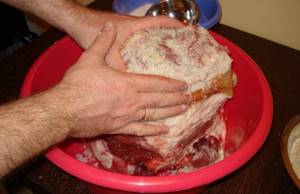
After 12 days it can be cut and eaten.
The use of lamb fat in folk medicine
This valuable and useful product is popular in medicine. It is famous for its medicinal properties and is in great demand among admirers of folk methods of combating various diseases. It is worth considering that fat is used as part of complex therapy, but does not replace it entirely.
For cough and bronchitis
Lamb fat is used as a cough medicine for children and adults. Its universal property lies in the possibility of its use not only internally, but also externally:
- External use. Thanks to the content of lanolin and a vitamin complex, lamb fat makes excellent ointments. When applied to the skin, the product retains heat well and increases blood circulation. The fat is rubbed on the back, feet, and chest. The patient is covered with a warm blanket and provided with rest. Treatment can be repeated until complete recovery;
- Internal use. For coughs, it is customary to drink a drink consisting of 1 teaspoon of lamb fat and a glass of boiled milk. The combination of ingredients improves the elimination of phlegm and toxins found inside the body that cause harm to it. The drink is consumed on an empty stomach. Lamb fat is also excellent for smokers to prevent lung diseases, and also as a remedy for pneumonia.
Important! Before rubbing your child with lamb fat, you should consult your doctor. In case of individual intolerance, any product made from animal fat can cause complications.
To relieve joint pain
It is useful to apply compresses to the area of concern. A thick layer of fat is applied to the problem area and wrapped in cling film for additional heating.
For varicose veins
Compresses are also suitable for people suffering from varicose veins. To make the veins less noticeable, it is recommended to add medicinal herbs to the fat mass - colchicum, sunflower root, celandine.
From wen
Melted fat tail fat is beneficial as a remedy for tumors of skin tissue, including fatty tissues. The mass is applied to the inflammation and rubbed for 15-20 minutes. This massage is effective, and the results are noticeable within a few weeks.
From heel spurs
We recommend reading: The healing properties of propolis with milk and contraindications for use
You can get rid of heel spurs using young sheep fat, propolis and onions. The ingredients are chopped, mixed thoroughly and left for a day in a dark place. The resulting paste is applied to the affected areas before bedtime. The same remedy helps with irritations, burns, dry calluses and many other skin lesions.
We recommend reading: The benefits and harms of leeks
Product Description
Lamb fat (also called fat tail) is a fatty deposit in the rear inner part of the carcass, near the tail. It is from this that the famous product is obtained, consisting of 97% pure fat and only 3% water, which distinguishes it from analogues of other animals.
The color is white and yellow and depends on the age of the animal:
- Rendered lard from old sheep has a yellow tint and is also characterized by a specific odor.
- White fat tail is obtained from the fat of young animals.
This is a very popular remedy among the population of the Caucasus, Tibet, Mongolia, and Central Asia. Widely used in Asian and Caucasian cuisine.
Varieties
Rendered sheep fat comes in three varieties:
- Higher. Reheated from fresh selected internal fat and fat tail. The color is white, rich, sometimes with a slightly yellowish tint, and when melted it is transparent. Used for preparing dishes and meat products. It has a characteristic lamb taste and specific smell.
- First. Made from selected raw lard. The consistency is similar to the highest grade, the color is also white, but has a slightly grayish, greenish tint.
- Second. Heated from ordinary raw lard. When melted, the fat is cloudy, with the taste of fried cracklings.

How to drown
The process of rendering fat is quite simple:
- Cut the lard into small pieces.
- Place it in an enamel or clay bowl and fill it with water. After an hour, the water needs to be drained. This is necessary in order to wash the product from residual blood and pieces of connective tissue.
- Prepare heat-resistant dishes (clay pot, cauldron). Pour some boiling water into the bottom. Place lard there and place in the oven at a temperature of about 150 °C. There is no need to close the lid. The heating time depends on the volume of the product being melted, it is set by eye, experimentally. Approximately 1.5 hours.
- After a while, you need to remove the pot from the oven and pass the fat through a sieve to filter out the hard cracklings. Leave the melted fat tail in the container; it will harden and turn white.
For convenience, the product can be cut into portioned cubes.
You can also melt lamb fat in a slow cooker.
The procedure is as follows:
- Rinse the lard.
- Cut it into small pieces or grind in a meat grinder.
- Place the product into the bowl.
- Select the “Baking” mode and bake for an hour.
- Change the mode to “Stew” and cook for about 2-3 hours, checking and stirring occasionally.
- Strain the finished product, place in a storage container and put in the refrigerator.
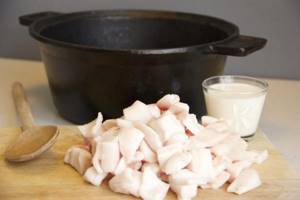
How to choose the right one
For a product to be healthy, it is important to purchase it only from reliable sellers who value their reputation.
Get to know the signs that distinguish natural fat from fake:
- light color, almost white;
- no ammonia smell;
- a quality product must be dry.
This knowledge will help you distinguish lamb fat from goat fat.
Storage rules
After purchasing, the fat tail is stacked and then placed in the refrigerator (mode - +2-5 ° C). The shelf life is 3-4 months, during which time it will not lose its beneficial properties. If it is not possible to melt, the fat tail should be frozen.
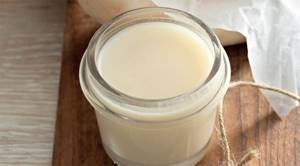
How is lamb fat used in cosmetology?
It has long been believed that lamb tail helps to prolong youth. Fortunately, this is true. Vitamins and nutritional properties help smooth the dermal layer, making it elastic. In addition, animal fat perfectly protects the skin from temperature changes. Due to these properties, lamb fat is popular as the main component in anti-aging face masks and nourishing body creams.
Nourishing body cream
The beneficial properties of lamb fat make it possible to make excellent creams from it, popular in East Asian countries, where women know the true price of beauty. The product easily penetrates skin cells and saturates them with valuable components. As a result, melted fat tail provides an incomparable effect, nourishing, whitening and smoothing the skin and preventing age-related changes.
To prepare a Thai mask you will need:
- lamb fat – 2 tbsp. l;
- grape or apricot seed oil – 50 g;
- beeswax - 1 tbsp. l.
The ingredients are heated in a water bath, mixed and poured into a jar for further use and storage.
For strengthening and growth of hair
To improve growth and strengthen the hair structure, it is useful to make a mask based on animal fat once a week. The product envelops hairs, protecting them from mechanical and temperature damage.
Recipe:
- rendered fat - 1 tbsp. l;
- honey - 1 tbsp. l;
- olive oil – 50 g.
Lamb fat and honey are heated to room temperature and then mixed with extra virgin olive oil. The mixture is applied to clean, damp hair and covered with a plastic cap for 40-60 minutes. After the procedure, the hair must be rinsed well with soapy water. The oil has a fairly greasy consistency, so it is difficult to wash it out of your hair. On the day of applying the mask, it is better not to plan any important events and stay at home.
Beneficial features
Let's talk in more detail about the benefits and harms of fat tail fat.
Compound
This product is considered unique due to its rich chemical composition.
He contains:
- B vitamins;
- vitamins A, E, D, K;
- selenium;
- zinc;
- phosphorus;
- potassium;
- magnesium;
- sodium;
- copper;
- iron;
- fatty esters (sterol, phosphatide);
- fatty acids (stearic, palmitic, oleic, linoleic).
Due to these components, rendered lard normalizes metabolic processes in the body and protects it from external negative factors, in particular from electromagnetic radiation.
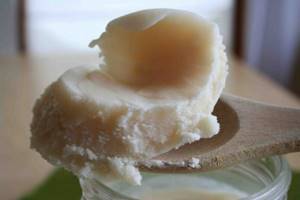
Calories and nutritional value
The product is high-calorie - 100 g contains 897 kcal. It contains more saturated fat than pork and beef lard; there are no proteins or carbohydrates at all.
The determination of portions of the baked product is also of interest:
- in 1 tsp. 8 g fat;
- in 1 tbsp. l. – 20 g;
- in 1 glass – 205 g.
It is generally accepted that including fat tail fat in the diet in small quantities (no more than 2 tablespoons per day) is the key to longevity and health.
What is good for the body
Rendered lamb fat is a product that has a number of healing properties.
Here are the main ones:
- Due to the content of vitamin B1, it stimulates brain activity and helps fight fatigue.
- It is a powerful prevention of diseases of the reproductive system: it helps women cope with infertility, and helps men avoid impotence.
- Rich in antioxidants, it fights free radicals, prevents the aging of the body and the development of cancer cells.
- Strengthens the immune system and resistance to colds.
- Helps to quickly restore strength after injuries and long-term illnesses.
- Reduces pain in bones and joints.
- Provides protection against UV radiation.
At the same time, it is easily absorbed by the body and does not overload the digestive tract.

Lamb tail in cooking
Despite the fact that lamb fat is a specific product with an unpleasant odor, it is popular in cooking. However, such an ingredient is rarely found in European cuisine. Sometimes it is used for frying potatoes, vegetables, and added to baked goods.
We recommend reading: Potatoes: beneficial properties and contraindications
Important! Since lamb tail contains cholesterol, excessive consumption of the product makes the blood thicker and can lead to the progression of heart disease.
In which countries is it popular?
Rendered lamb lard is used mainly in the national cuisines of Asia. In these countries, its popularity is due not only to its beneficial properties, but also to the inability to replace the product with something else. Lamb fat is a secret ingredient in oriental cuisine, without which traditional recipes are considered incomplete and incorrect. In Kalmykia, there is even a unique drink made from black tea with lamb fat, spices and salt. In some regions of the East, rendered lard is added to sweets, and Syrians cannot even imagine breakfast without it.
What dishes can you prepare?
Fat tail retains its benefits even after heat treatment, and when smoked it is used as a secret ingredient in such dishes:
- traditional Uzbek pilaf;
- kebab;
- kharcho;
- manta rays;
- Ossetian pies.
Culinary masterpieces prepared with lamb fat have a specific flavor that is highly valued in Eastern countries. This food is best eaten hot, with spices and vegetable side dishes.
Important! Fat tail fat has great benefits when salted, however, its abuse can also cause harm. The recommended daily dose of lard is 100 g.
Lula kebab
- Time: 40 minutes.
- Number of servings: 4 persons.
- Calorie content of the dish: 299 kcal per 100 grams.
- Purpose: for lunch, dinner.
- Cuisine: oriental.
- Difficulty: easy.
Long-livers of the East claim that the guarantee of their health and well-being lies in special food products, among which is fat tail. Lula kebab is a national dish in the Caucasus, Central Asia, and Turkey. One of the ingredients is lamb fat, which gives the whole dish a special taste and aroma. Zira and coriander are spices that go perfectly with lamb pulp; you can adjust their quantity at your discretion.
Ingredients:
- lamb pulp – 500 g;
- fat tail – 150 g;
- coriander – 20 g;
- zira – 20 g;
- salt – 5 g;
- onions – 2 pcs.;
- ground black pepper – 2 g.
Cooking method:
- Traditionally, lamb with fat tail is chopped into minced meat with a sharp knife, but this is a very long and painstaking work that only real professionals in this matter can do. To speed up the cooking process, you can use a meat grinder or blender.
- Add spices to the minced meat and “beat” it with your hands for some time so that it is saturated with air and enriched with the aroma of spices.
- The mixture must be tested for strength so that it does not collapse during frying. To do this, you need to roll one sausage and place it on a skewer. If the minced meat holds well, then you can start frying, otherwise you need to knead it further or add one chicken egg.
- Wet your hands with water, form a meat patty weighing approximately 150 grams and distribute evenly on a skewer.
- Fry lula kebab over coals until golden brown on all sides.
- Serve the dish with freshly sliced vegetables and plenty of herbs.
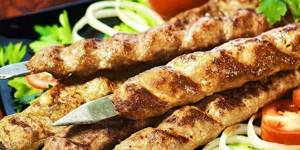
Harm of lamb fat and contraindications
Like any other product of animal origin, lamb fat brings not only benefits to the body, but also harm. There are diseases for which eating lamb is strongly discouraged. Among them:
- gastrointestinal problems: gastritis, liver problems, ulcers and other diseases that increase stomach acidity;
- excess weight: high calorie content and cholesterol content, which has a cumulative effect, will only aggravate the situation;
- cardiovascular diseases;
- individual intolerance when applied to the skin;
- Children under 1 year of age and elderly people are not recommended to consume this heavy product.
Important! The benefits of fat tail fat for human health end where the abuse of the product begins. By observing the measure, you can avoid any unpleasant consequences.
Fat-tailed breeds of sheep
In sheep breeding, there are only three fat-tailed varieties. These include:
- Edilbaevskys. This is the result of crossing Astrakhan rams with Kazakh sheep. Rams weigh up to 120 kg, females are almost twice as light. Coat color is red, brown and black. Black individuals produce good meat and in the greatest quantity; an explanation for this fact has not yet been found. Over the course of a year, individuals produce up to 3.5 kg of wool and about 120 liters of high-fat milk. It is good to use for making butter or cheese. Animals are unpretentious to food and living conditions. The main thing is pasture maintenance. Distribution area: Tatarstan, Kazakhstan and certain regions of the Russian Federation.
- Kalmyk sheep. They began to be actively bred in Mongolia and western China. The breed was created as a result of crossing local varieties of sheep. Such sheep can be white or black, wool yield is up to 4 kg per year. The weight of an adult ram reaches 120 kg. This breed of sheep of all fat-tailed varieties produces the highest quality products. This applies to meat, even in adults it is soft and tender, as if it were the meat of young animals. The wool is also of different quality; it is the softest of all fat-tailed breeds.
- Gissar sheep are a product of crossing Tajik and Uzbek breeds. The color is most often reddish-brown with different shades. These are the largest animals of all fat-tailed breeds; a ram can weigh up to 190 kg, a sheep - up to 90 kg. But this breed produces the least wool (about 2 kg), moreover, it is of poor quality and is not very valued. Sheep of this breed are kept exclusively for meat: it is tender and tasty, especially since there is a lot of it.
How to choose a fat tail when purchasing
A high-quality product is the key to a good dish: it is natural fat tail that will bring maximum benefits to the human body. To choose the right raw materials, you should consider some recommendations:
- A good fat tail has a specific but pleasant smell. Only a stale or spoiled product can smell like stale meat or ammonia;
- In order not to confuse fat tail with interior fat, you need to pay attention to its consistency. The first melts even at room temperature, resembling a thick cream, while the second is harder and less healthy, and can only be melted in a steam bath;
- The color should be milky white, with possible yellowing. Saturated gray and greenish shades indicate improper storage;
- To avoid harm typical of animal raw materials, it is better to make sure that the seller of the product has a veterinary certificate about the health status of the livestock.
What is fat tail?
In historical materials, the first mentions of the fat tail appeared about 3 thousand years BC. The presence of a fat tail has been found in animals depicted on dishes in Sumerian cities. Since then, the fat tail has appeared every now and then in some sources related to Asia. Also, mentions of fat tail can be found in historical information about Arab countries, Iran, Kazakhstan and even Transbaikalia.
The fat tail, or fat deposit, tends to be deposited on 3-5 vertebrae, if you count from the base of the tail. Its size directly depends on the characteristics of the breed and there are cases when the fat tail itself weighed up to 30 kg. The fat tail of a ram is approximately the same as the hump of a camel. Such fat accumulations are necessary for consumption during periods of feed shortage.
In appearance, the fat tail is a rounded surface covered with the same hair as the animal itself. In individuals of fat-tailed breeds, the most pronounced deposits appear during intensive fattening and favorable housing conditions, even despite the genetic peculiarity. Also, the development of fat tail depends on the level of salt in the soil in the place of residence and the characteristics of the grass consumed.

Features of fat-tailed sheep
Fat-tailed sheep are especially notable for their unpretentiousness. Moreover, this is expressed literally in everything: tolerance to any climatic conditions, undemandingness in care and nutrition. The main thing is to have the opportunity to graze on good meadows. Keeping them in dark, unventilated rooms is the only thing that such sheep cannot tolerate.
Important! The young are characterized by a rapid growth rate: by six months the animal weighs about 50 kg. From such a lamb you get 20-25 kg of tender meat and 5-7 kg of fat tail fat.
Herding fat-tailed sheep is difficult. This is due to many factors. For example, these sheep do not choose their leader, so they simply have no one to follow. Also, fat-tailed sheep have poor orientation in space: having strayed from the flock, the animal will no longer be able to return there on its own. In addition, sheep of such breeds are characterized by increased timidity and, at the slightest threat, rush in all directions.


